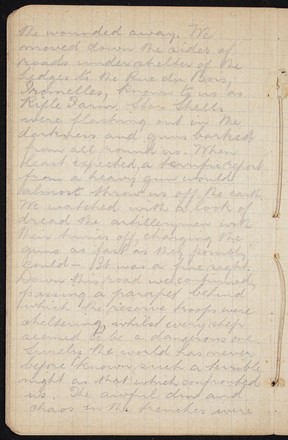The Battle of Fromelles took place in
northern France, in between the Somme Valley and the Belgian border. This was
the first major engagement for Australian troops on the Western Front.
WJA Allsop, known to others as
‘Allan’, enlisted in the AIF on 23 July 1915 at the age of 22. Allsop served in
both Egypt and France, and was assigned to the 8th Field Ambulance,
15th Field Ambulance, and later the Australian Corps Signal Company.
He returned to Australia on the Sardinia
in April 1919.
This journal is one of a larger collection
of five diaries purchased from Allsop in 1920 which detail his experiences
between July 1915 and December 1917. They were acquired as a part of the
European War Collecting Project (also known as the Soldiers’ Diaries Collection
or War Diaries Collection), a program developed by the library in order to
compile a rich assortment of first-hand accounts by Australian soldiers during
World War I.
In order to transfer the wounded to the
ambulance motor cars, Allsop and his partner Stan Wilson were forced to
manoeuvre their way through the trenches. He describes the continuous trips, ‘Backwards & forwards we travelled between
the firing line and the R.A.P. [Regimental Aid Post] with knuckles torn and bleeding due to the narrow passage ways.
"Cold sweat", not perspiration, dripped from our faces and our breath
came only in gasps. The communication trench was about 1½ miles long. By the
time we had completed 2 trips (six miles) with the numerous zig-zag turns in
the trench and the stoppages caused by the traffic up and down, we were weak
and completely exhausted.’ – Allan Allsop (transcript, page 17)
Allsop’s role as a stretcher bearer proved
just as dangerous as that of the soldiers fighting on the front line. He
recounts, ‘No sooner had I entered this
sap "Piney Avenue" than a bullet struck my steel helmet and nearly
knocked it off my head. The sound caused my mates in front of me to look round.
Happily the bullet came at an angle so that the roundness of the helmet caused
it to glance off.’ – Allan Allsop (transcript; page 15)
When the dust settled on the 20th
July, the battle had been deemed a failure.
‘So the adventure proved a failure
though at different stages of the battle cheerful messages came through as
follows "They are into the 4th line" – "Complete system of
German trenches taken and being held at all costs" – "Some are
through into the village of Fromelles". Then, when we finally heard of the
failure, various reports and opinions flew round. There is no doubt, however,
but that orders were not adhered to, inasmuch as some troops went further than
they should have gone.’ – Allan Allsop (transcript; page 19)
In 2008, a project was undertaken to
discover the location of mass graves nearby the Fromelles battlefield believed
to hold the remains of soldiers who died during the battle. Through a
concentrated effort of the project team, the remains of 250 individuals were
recovered. The soldiers were properly buried in 2010 at the Fromelles [Pheasant
Wood] Military Cemetery, and as of mid-2015, 144 of the 250 soldiers had been
identified.



 Back to list
Back to list